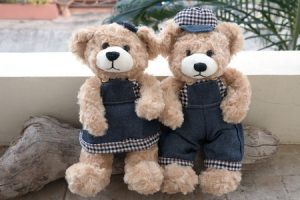
Arctophilia (from the Greek arktos meaning bear and philos meaning love), or the art of teddy bear collecting, has probably been around about as long as have teddy bears. After all, who wouldn’t want to keep their childhood friend as long as possible? Adults as well as children love the huggable toys. Teddy bears were born in 1902; by 1906, they had become noticed by adults as well as children, in no small part to the role teddies played in the re-election of the United States’ president Theodore “Teddy” Roosevelt.
Interest in teddy bears waned during the two World Wars and the Great Depression when toys were considered luxuries and adults had more on their minds than mere teddy bears.
Peter Bull: Arctophile
Then along came Peter Bull, an arctophile of the first order, who was not only a teddy bear collector but famous. Considered by many to be the father of modern day teddy bear collector and fandom, Bull made collecting teddies popular, and respectable, with his book Bear with Me published in 1969.
Bull’s book, along with the 1964 book Teddy Bears and How to Make Them by toymaker Margaret Hutchings, fueled the teddy bear collecting craze which had begun slowly in the early 1960’s as part of a movement toward sentimentalism and a nostalgia for the past which was possibly a reaction to the pop culture of the 1960’s and ‘70’s.
Collecting teddy bears can be as simple as buying teddy bears that appeal to you, whether new or used, or as complex and expensive as buying teddies through antique stores, auction houses or directly from the manufacturer (if they’re still in business).
Where to begin? If you’re going to collect teddies as a hobby, go out and buy a teddy bear you like and are drawn to. But if you’re going to be a serious teddy bear collector, there’s a lot to be considered, including such topics as manufacturer, age, condition, and price.
But first let’s look at Peter Bull, considered by many to be the father of teddy bear collecting.
